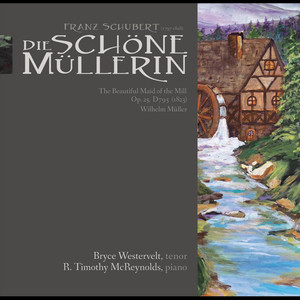
Die schöne Müllerin
- 流派:Classical 古典
- 语种:英语
- 发行时间:2012-01-17
- 类型:录音室专辑
- 歌曲
- 时长
简介
Notes: Die schöne Müllerin is considered by many to be composer Franz Schubert’s most important work. In 1823, Schubert set 20 poems written by Wilhelm Müller to an original score, which was published the following year. Die schöne Müllerin, roughly translated as “the beautiful maiden of the mill,” tells the story of a young miller, who sets out on a journey seeking work, falling in love along the way. The miller’s journey begins as he wanders along the path of a brook (Das Wandern). As he travels onward, the young vagabond wonders where the stream will lead him (Wohin?). The brook brings the young man to a mill (Halt!). To his delight, the mill brings both work and love—the latter in the form of the mill owner’s daughter. He thanks the brook for the work and the maiden (Danksagung an den Bach). As time progresses, the miller’s infatuation with the mill owner’s daughter deepens. To his frustration, the young woman does not notice him, no matter how hard he works (Am Feierabend). The young miller turns to the brook for clarity. Does the mill owner’s daughter love him as he loves her (Der Neugierige)? He is impatient for answers (Ungeduld). The young woman continues to be indifferent to his morning greeting (Morgengruß). Given his rebuffed advances, the young man confides in the flowers about his love, wanting them to express to her what he cannot manage to express himself (Des Müllers Blumen). Things get more confusing for the young miller. He believes there is hope for requited love after the pair shares a moment under the trees (Tränenregen). The young miller is now convinced of the maiden’s love and devotion (Mein!). In his excitement, he turns to a lute, which hangs from a green ribbon on the wall, to help him express his joy in song (Pause). The young miller thinks little of the green ribbon from which the lute hangs, until the young maiden asks to have it. She is fond of green, so green becomes the young man’s favorite color, too—for better or worse (Mit dem grünen Lautenbande). The young miller’s joy turns to anger, when a hunter arrives on the scene, “hunting” the love of the mill owner’s daughter (Der Jäger). The young man’s tender words for the object of his affection turn to words of scorn, as he becomes jealous and possessive, urging the brook to scold the maiden for flirting with the hunter (Eifersucht und Stolz). The young man starts feeling sorry for himself. If it’s hunters and green she likes, he’ll give her both. He will hunt death and dress in the green grass of the grave (Die liebe Farbe). Sinking deeper into his depression over the loss of his maiden, the young man feels that the green of nature that surrounds him is taunting him, throwing salt into his wounds (Die böse Farbe). The young man has saved every flower the maiden had given him. Each flower, now wilted, is a sign to him of the death of their love. Still, he hopes the maiden will remember him, bringing their love back to life, the way nature renews itself in the spring (Trockne Blumen). That glimmer of hope cannot break through the darkness. The young miller turns to the brook, and the brook speaks back, trying to console his broken heart (Der Müller und der Bach). Sadly, his heart will not be healed. The brook provides eternal rest, offering a lullaby as the young miller sleeps in death (Des Baches Wiegenlied). © Krista Westervelt, 2012

